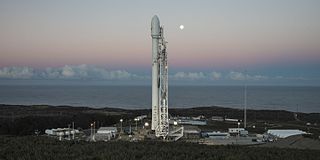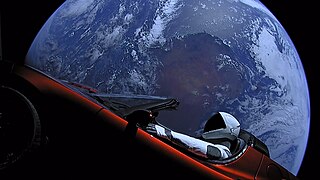
National Security Space Launch (NSSL) is a program of the United States Space Force (USSF) intended to assure access to space for United States Department of Defense and other United States government payloads. The program is managed by the Assured Access to Space Directorate (SSC/AA) of the Space Force's Space Systems Command (SSC), in partnership with the National Reconnaissance Office.

The Boeing X-37, also known as the Orbital Test Vehicle (OTV), is a reusable robotic spacecraft. It is boosted into space by a launch vehicle, then re-enters Earth's atmosphere and lands as a spaceplane. The X-37 is operated by the Department of the Air Force Rapid Capabilities Office, in collaboration with United States Space Force, for orbital spaceflight missions intended to demonstrate reusable space technologies. It is a 120-percent-scaled derivative of the earlier Boeing X-40. The X-37 began as a NASA project in 1999, before being transferred to the United States Department of Defense in 2004. Until 2019, the program was managed by Air Force Space Command.

FalconSAT is the United States Air Force Academy's (USAFA) small satellite engineering program. Satellites are designed, built, tested, and operated by Academy cadets. The project is administered by the USAFA Space Systems Research Center under the direction of the Department of Astronautics. Most of the cadets who work on the project are pursuing a bachelor of science degree in astronautical engineering, although students from other disciplines join the project.
The Space Test Program (STP) is the primary provider of spaceflight for the United States Department of Defense (DoD) space science and technology community. STP is managed by a group within the Advanced Systems and Development Directorate, a directorate of the Space and Missile Systems Center of the United States Space Force. STP provides spaceflight via the International Space Station (ISS), piggybacks, secondary payloads and dedicated launch services.

Space Launch Complex 4 (SLC-4) is a launch and landing site at Vandenberg Space Force Base, California, U.S. It has two pads, both of which are used by SpaceX for Falcon 9, one for launch operations, and other as Landing Zone 4 (LZ-4) for SpaceX landings.

Falcon Heavy is a partially reusable super heavy-lift launch vehicle that can carry cargo into Earth orbit, and beyond. It is designed, manufactured and launched by American aerospace company SpaceX.

Several new rockets and spaceports began operations in 2016.
The EELV Secondary Payload Adapter (ESPA) is an adapter for launching secondary payloads on orbital launch vehicles.

This article documents notable spaceflight events during the year 2019.

This article documents notable spaceflight events during the year 2018. For the first time since 1990, more than 100 orbital launches were performed globally.

USA-299, also referred to as USSF-7 and Orbital Test Vehicle 6 (OTV-6), is the third flight of the first Boeing X-37B, an American unmanned vertical-takeoff, horizontal-landing spaceplane. It was launched to low Earth orbit aboard an Atlas V launch vehicle from SLC-41 on 17 May 2020. Its mission designation is part of the USA series.

Orbital Test Vehicle 7 (OTV-7), also referred to as United States Space Force-52 (USSF-52) or USA-349, is the fourth flight of the second Boeing X-37B, an American unmanned vertical-takeoff, horizontal-landing spaceplane. It was launched to low Earth orbit aboard a Falcon Heavy rocket from LC-39A on 28 December 2023.










